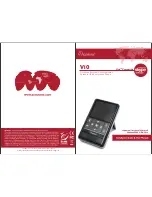
TLE-02D
Portable Digital Communications Unit
8
3.2. Description of the rear panel
A series of combo XLR3-Jacks (1 and 2) are found on the front panel, one is connected to each
channel of each input. This type of connector allows the connection of male XLR3 or ¼” male
telephone type jack plugs, therefore admitting balanced or asymmetric signals.
The headphone outputs (4) are provided with ¼” stereo telephone jacks.
The Mic/Tape channel possesses a micro/line level selector switch (3).
The numbered elements and their use are described in the following selection
(1)
Microphone Inputs 1 and 2
(2) Micro/Line
Input
(3) Mic/Line
switch
(4)
Heaphones Output 1 and 2
(5)
RS232 Data channel and Control port. Sub-D 9 Female
(6)
RJ45 ISDN line connector
(7)
RJ11 Analogue Telephone Line (CTN) connector
(8)
Mode selector switch ISDN (ISDN) – Analogue Telephone Line (CTN)
(9)
Dial mode selector switch Pulse – DTMF Tones in CTN mode
(10) 4 Wire interface
(11) Auxiliary Input trim level
(12) Power supply connector (DC-INPUT)
Microphone Inputs 1 and 2
The microphones are normally supplied with the appropriate connectors for direct connection to
the Audiocodec. The connector wiring is shown below:
XLR connectors
¼” Jack connectors
1: ground
sleeve: ground
2: microphone V+
tip: microphone V+
3: microphone V-
ring: microphone V-
Mic/Line Input
A cable with either a male XLR3 or ¼” stereo Jack must be used. The connector wiring is the
same as that for the microphone inputs.
Mic/Line switch
To select microphone input level, the switch is set to the rest position (switch button out), and to
select line input level, the switch is set to the activated position (switch button in).
4
12
5
1
9
7
10
2
3
8
6
11
USO
RESTRITO









































